Do you have a question about the Carrier 25HNB5 and is the answer not in the manual?
Essential safety precautions, warnings, and hazard identification for proper installation and operation.
Guidelines for optimal unit placement, tubing, and installation to ensure performance and minimize noise.
Procedures for unpacking, inspecting, and preparing the unit and installation site.
Specifies the necessary clearances around the unit for proper airflow, wiring, and service access.
Instructions for elevating the unit to provide clearance for snow, ice, and drainage.
Detailed steps for connecting refrigerant lines, including adapter tube installation and tubing requirements.
Information on connecting the outdoor unit to approved indoor units and refrigerant charge considerations.
Guidance on proper brazing techniques for refrigerant lines, including safety precautions and materials.
Procedure for installing the liquid line filter drier to the indoor coil for system protection.
Instructions for performing leak tests on all joints, indoors, outdoors, and refrigerant tubing.
Methodology for evacuating the system to 500 microns to ensure removal of air and moisture.
Guidelines for connecting power and control wiring, ensuring compliance with codes and safety standards.
Instructions for routing and connecting 24V control wires for thermostat and system communication.
Important steps to verify all factory and field wiring connections are secure and properly routed.
Information on powering the crankcase heater before unit start-up, especially for long line applications.
Guidance on installing any additional electrical accessories included with the unit.
Ensuring the Outdoor Air Temperature (OAT) and Outdoor Coil Temperature (OCT) thermistors are correctly installed.
Steps to properly start up the system after installation, including valve operation and thermostat settings.
Procedures for checking and adjusting the system's refrigerant charge for optimal performance.
Using the heating check chart to verify system operation and refrigerant charge relationship.
How the system operates with a standard thermostat for cooling and heating cycles.
Overview of the outdoor unit control system functions for heat pump operation.
Understanding the LED indicators for system communication and operational status.
Details on the operation of the crankcase heater during off cycles below a specific outdoor temperature.
Information on when the outdoor fan motor is energized, including delays and special conditions.
Explanation of various time delays implemented in the system for protection and efficiency.
How a utility can interrupt compressor operation via the UTIL input for peak load management.
Methods for enabling low ambient cooling, distinguishing between Infinity and standard thermostat control.
Configuration and operation of defrost cycles, including interval times and termination conditions.
Procedures for manually initiating defrost and how the system handles defrost hold conditions.
Explanation of the Quiet Shift-2 feature for reducing noise during defrost cycle transitions.
Details on the liquid line solenoid accessory for heat pump long line applications.
Overview of the functions managed by the heat pump control board.
Information on connecting field wiring for Infinity communicating and standard thermostat systems.
Explanation of the compressor's internal pressure relief and overload protection mechanisms.
Diagnosing issues when communication between system components is lost.
How high and low pressure switches protect the compressor and system operation.
Identifying and resolving issues related to the outdoor unit control board failure.
Addressing problems related to low control voltage (brown out) and compressor voltage sensing.
Understanding thermal cutouts, lockouts, and their impact on compressor operation.
Diagnosing problems with contactor operation and 230V power supply to the compressor.
Troubleshooting faults related to outdoor air and coil temperature sensors.
Comparing thermistor readings and understanding default operation during sensor failures.
Interpreting amber LED status codes to diagnose system problems and faults.
Essential final checks before leaving the job site to ensure safe and proper installation.
Information on periodic maintenance required for continued high performance and equipment longevity.
Key guidelines and safety notes for servicing systems using Puron (R-410A) refrigerant.
Essential safety precautions, warnings, and hazard identification for proper installation and operation.
Guidelines for optimal unit placement, tubing, and installation to ensure performance and minimize noise.
Procedures for unpacking, inspecting, and preparing the unit and installation site.
Specifies the necessary clearances around the unit for proper airflow, wiring, and service access.
Instructions for elevating the unit to provide clearance for snow, ice, and drainage.
Detailed steps for connecting refrigerant lines, including adapter tube installation and tubing requirements.
Information on connecting the outdoor unit to approved indoor units and refrigerant charge considerations.
Guidance on proper brazing techniques for refrigerant lines, including safety precautions and materials.
Procedure for installing the liquid line filter drier to the indoor coil for system protection.
Instructions for performing leak tests on all joints, indoors, outdoors, and refrigerant tubing.
Methodology for evacuating the system to 500 microns to ensure removal of air and moisture.
Guidelines for connecting power and control wiring, ensuring compliance with codes and safety standards.
Instructions for routing and connecting 24V control wires for thermostat and system communication.
Important steps to verify all factory and field wiring connections are secure and properly routed.
Information on powering the crankcase heater before unit start-up, especially for long line applications.
Guidance on installing any additional electrical accessories included with the unit.
Ensuring the Outdoor Air Temperature (OAT) and Outdoor Coil Temperature (OCT) thermistors are correctly installed.
Steps to properly start up the system after installation, including valve operation and thermostat settings.
Procedures for checking and adjusting the system's refrigerant charge for optimal performance.
Using the heating check chart to verify system operation and refrigerant charge relationship.
How the system operates with a standard thermostat for cooling and heating cycles.
Overview of the outdoor unit control system functions for heat pump operation.
Understanding the LED indicators for system communication and operational status.
Details on the operation of the crankcase heater during off cycles below a specific outdoor temperature.
Information on when the outdoor fan motor is energized, including delays and special conditions.
Explanation of various time delays implemented in the system for protection and efficiency.
How a utility can interrupt compressor operation via the UTIL input for peak load management.
Methods for enabling low ambient cooling, distinguishing between Infinity and standard thermostat control.
Configuration and operation of defrost cycles, including interval times and termination conditions.
Procedures for manually initiating defrost and how the system handles defrost hold conditions.
Explanation of the Quiet Shift-2 feature for reducing noise during defrost cycle transitions.
Details on the liquid line solenoid accessory for heat pump long line applications.
Overview of the functions managed by the heat pump control board.
Information on connecting field wiring for Infinity communicating and standard thermostat systems.
Explanation of the compressor's internal pressure relief and overload protection mechanisms.
Diagnosing issues when communication between system components is lost.
How high and low pressure switches protect the compressor and system operation.
Identifying and resolving issues related to the outdoor unit control board failure.
Addressing problems related to low control voltage (brown out) and compressor voltage sensing.
Understanding thermal cutouts, lockouts, and their impact on compressor operation.
Diagnosing problems with contactor operation and 230V power supply to the compressor.
Troubleshooting faults related to outdoor air and coil temperature sensors.
Comparing thermistor readings and understanding default operation during sensor failures.
Interpreting amber LED status codes to diagnose system problems and faults.
Essential final checks before leaving the job site to ensure safe and proper installation.
Information on periodic maintenance required for continued high performance and equipment longevity.
Key guidelines and safety notes for servicing systems using Puron (R-410A) refrigerant.
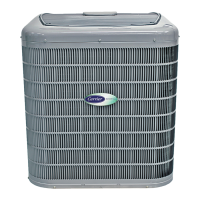
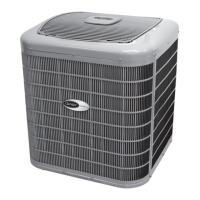

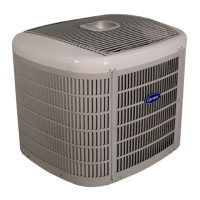
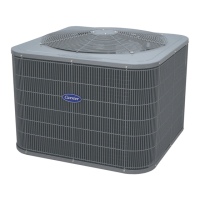
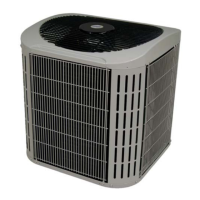
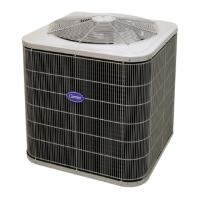


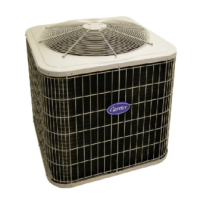
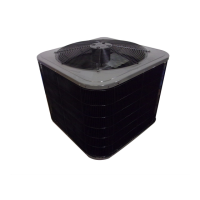

